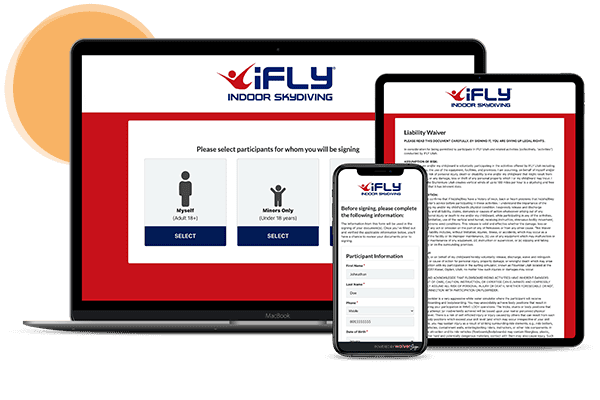
Here at WaiverSign, we talk a lot about liability waivers for tour and activity operators, but they're not the only businesses that need protection from legal kerfluffles. In fact, if any industry has a need to use a liability waiver, it's the healthcare industry—after all, it's hard to get more serious than "life and limb." Without a properly worded waiver, even a single medical mishap can ruin a practice.
That, dear friends, is where the medical liability waiver comes in.

In general, a liability waiver (sometimes called a "release of liability") is a legal agreement where the signer does two things: 1) "waives" (or gives up) the right to sue in the event of misfortune or "simple negligence," and 2) releases a person or organization from "liability" (i.e. “legal responsibility”). In order for both of those actions to be valid, however, the waiver needs to explain the risks involved in the given activity, and the signer needs to be given time to read it.
Medical liability waivers work the same way but are signed by patients, and are tailored to the specifics of the healthcare industry. A good medical waiver is carefully written so that medical professionals won’t be unduly held responsible for things that are a) outside their control, or b) not wholly their fault. It helps prevent patients or their families from blaming practitioners for things like complications, side effects, or a patient's ignorance.
It's important to be aware, though, that no waiver is foolproof. Under the right circumstances, a plaintiff may win in a legal battle even if their complaint is covered by the waiver. More importantly, there are things that no waiver can cover, such as "gross negligence," "malpractice," or intentional harm.
Finally, we want to stress that the best waivers (meaning the most effective ones) are bespoke—they're unique to both the circumstance and the provider. Sure, you can just snag a template you found online and insert the names and verbiage you need, but we don't recommend it. You'll be much better protected if you work with a legal professional to design a custom waiver that addresses your specific needs (and only your needs; extra, irrelevant stuff can get your waiver thrown out of court).
Looking for a Medical Release Form or HIPPA Authorization
This type of agreement is different than a medical liability waiver, but used by nearly all healthcare organizations. See an example Medical Release and HIPPA Authorization Form.
Medical liability waivers, as you might expect, are used by medical professionals. For example:
All of the above are providers that might (and probably should) use a waiver. They may even be used by less traditional or obvious wellness professionals, such as chiropractors, massage therapists, practitioners of alternative medicine, or veterinary professionals.
Essentially, any trained, licensed professional who monitors or attempts to modify (i.e. "improve") the operation of the body of a person (or animal) stands to benefit from using a medical liability waiver.
It’s not just individuals, either. In many cases, it's the facility (the clinic, hospital, or otherwise) that administers the waiver. When that happens, the medical waiver usually includes language that includes the professionals that work at the facility as protected entities.
Why do so many different professionals use medical liability waivers? Because there are inherent risks in treating illness, no matter what kind it is, and the more severe the illness, the greater the risks.
Typically, though, medical liability waivers are only required when the level of the risk exceeds a minimum threshold. In other words, you may sign a simple, generic waiver at a clinic for things like refilling prescriptions or getting a flu shot and will only have to sign a waiver unique to the procedure when it gets more invasive (as with surgery).

Now, if you've ever had a major medical procedure done yourself, you may be a little confused at this point, since a medical liability waiver probably wasn’t the only document you were required to sign. Most likely, you were also required to sign an informed consent form (sometimes called a "medical consent form" or a "consent to treat form").
If that's the case, you're probably curious why they didn't combine both into a single document, or why a medical liability waiver doesn't count as both. Those are common questions, and providers don’t always do a good job of explaining the difference, so we’ll help them out by doing that here.
Informed consent forms are used so patients can declare their willingness to undergo a specific treatment, regardless of risks or alternative options. Without them, they can claim in court that they didn't agree to treatment and that they were treated against their will.
Medical liability waivers are releases, meaning that they're used so that patients can confirm that they won't pursue legal action if something goes wrong during the procedure (barring gross negligence or malpractice).
Where informed consent forms state something similar to "I know the risks and I still want treatment, and I won't claim you treated me without my permission," medical liability waivers say something along the lines of "I know the risks, and I won’t blame you if something goes wrong."
This is complicated enough when you're signing for yourself, but it gets even more complicated when the patient receiving treatment can't do so. The most common example is when a minor is receiving treatment; in this case, the parent or guardian signs a "parental consent form" on their behalf (though, depending on age, the patient may still have to sign an "informed assent form").
Similarly, when a patient isn't conscious, coherent, or of sound mind, authority is usually given to the next of kin to sign for them. The only time this isn't required is when treatment is addressing a life-threatening condition. In these cases, consent is assumed, since otherwise, they won't live long enough to even complain about it.
This is also where DNR ("Do Not Resuscitate") forms come in, as they're essentially the exact opposite of a consent to treat form.
Bottom line: consent forms grant permission to providers, while medical liability waivers release them from responsibility.
Ok, here's where what we do becomes relevant. If you're someone who uses medical liability waivers on a regular basis, regardless of what you do or why you need one, you've probably run into the inherent issues with doing it all on paper (and there are quite a few of them).
For one, you always have to have copies on hand. Sure, you probably have a decent printer/copier on-site, but if you're totally out of copies you have to go digging for the digital file in order to print more (and wait times in medical facilities are already long enough as it is).
For another, printing costs money, something you're all too aware of whenever you have to buy another box of paper, replace an ink cartridge, or have that fancy printer repaired.
Then there are issues with people signing them by hand. Some people have worse handwriting than the doctors at your clinic, making them virtually illegible. Beyond that, there isn’t much document integrity, seeing as signers can just cross stuff out or write stuff in (which can seriously undermine your waiver in court).
And don't get us started on filing the paper waivers. Finding anything in that mess (even if it's properly organized) is scarier than any needle.
The good news is that, with the right tools, medical liability waivers can be administered, signed, and stored digitally, eliminating all of these issues. But where, oh where, could you find such tools?
We know how frustrating paper waivers can be, even though we learned those hard facts in a completely different industry. We were using paper waivers for our adventure travel businesses, and let's just say it was...less than fun. That's the whole reason we built WaiverSign—so we didn't have to deal with those drawbacks anymore.
With WaiverSign, you can create an unlimited number of templates (for your consent forms, liability waivers, and anything else you need signed), store an unlimited number of signed documents, and allow your patients to sign from nearly anywhere.
Perhaps best of all, you can finally give these documents to patients in advance, ditching the "signed under duress" argument at last.
It's a robust system with a ton of other features designed to make life easier for you, and we'd love to show you how it works. Just contact us, and we'll chat with you about how to use WaiverSign, then give you the keys and let you drive, giving you a chance to see if it works for you. Oh, and you get to try it for free. Did we mention that part?

Don't wait to make the next step in streamlining your business.
Try It Free